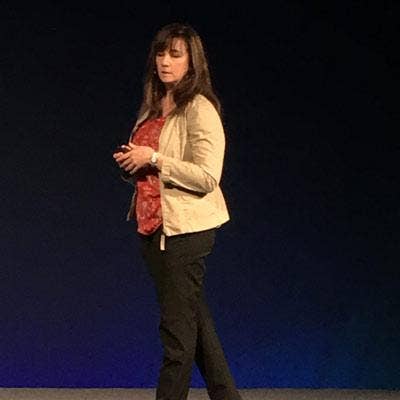Tech Data: Solution Providers Must Shift Focus From Products To Solutions, Business Outcomes

Solution providers that aren't ready to meet the fast-changing requirements of businesses that today are less ikely to rely on traditional IT infrastructures are putting themselves at risk.
Preparing to be a future-facing solution provider requires a lot of changes in how to approach IT, said Andrea Miner, director of business intelligence and corporate strategy at Clearwater, Fla.-based distributor Tech Data.
Miner, speaking before an audience of solution providers at last week's Tech Data Channel Link conference in Austin, Texas, said too many solution providers are still at the "second platform" stage of IT. The second platform, as characterized by research firm IDC, is a focus on client/server business with Ethernet the primary connectivity solution and PC workstations the primary user device.
That business is still growing, but at a projected anemic growth rate from 2018 to 2021, after which it will start to shrink, Miner said. The real growth will come in what IDC terms the "third platform," which is characterized by a shift to cloud computing, wireless networking, ubiquitous user access to IT resources, and the Internet of Things, she said.
To capture the revenue growth promised by the third platform, which goes hand in hand with businesses' increased investment in their digital transformation projects, solution providers will need to change how they do business, Miner said.
Solution providers will need to be less broad technology-focused and become more specialized, she said. It is also important for them to be more long-term focused on developing business, with business done based on long-term relationships rather than single deals, she said.
Solution providers will no longer succeed by working with customers' IT departments, but will instead need relationships with customers' business drivers. "You will have to focus on capturing the mindshare of the line-of-business people as well," she said.
It is the line-of-business people who influence 80 percent of all technology purchases and who fund 60 percent of al technology purchases, Miner said.
But even as the purchasing center point moves toward these people, there is growing confusion as they are constantly dealing with hype, Miner said.
"They need help in understanding the trends," she said. "They need to understand how to meet their needs in a way that is different from the old-school way."
To make this work, solution providers need to shift their conversations from IT performance to business outcomes, including such things as innovation, business agility, customer experience, business operations costs, and so on, Miner said.
"New business models are coming from new ways to consider business outcomes. … It opens up opportunities you might not have seen before," she said.
Solution providers said that Mine ris spot on in terms of where they need to invest for future growth.
Small and midsize business are hesitant to move everything to the cloud and are slow in adopting things like cloud services, said John Hill, president and CEO of Tech Sage Solutions, a San Antonio-based solution provider with a strong focus on the SMB market.
"I agree with Andrea that we need to be better at educating customers," Hill told CRN. "We need to help customers understand how the conversations are changing."
Some of the low-hanging fruit is already taken care of, Hill said. For instance, only two of his customers still have on-premises servers for Microsoft Exchange, while the majority have adopted Office 365.
"That's been a relatively easy conversation," he said. "But getting them to give up their servers is a different conversation. We haven't had a lot of success yet. Maybe part of that is my hesitation. If we have a server installed with a smaller customers, I may be worried about losing the services business around that server."
Conversations about changing how smaller businesses do IT have been a struggle, said Andrew Bialock, co-president and senior engineer at Advanced Systems Integrators, a Holyoke, Mass.-based solution provider working with Tech Data.
"Customers often ask the wrong questions," Bialock told CRN. "A school might ask, 'How many Chromebooks can I get?' instead of what solutions they can get. The conversations today have to be around solutions. If a school needs help with the cloud, we can't talk about the product first."
However, some customers require a lot of help before solution providers can start talking about solutions. A good part of ASI's business is with schools in western Massachusetts where there might be up to 70 miles between schools and where they depend on dial-up modems, Bialock said.
"Capacity on demand, Device as a Service, and Tech as a Service are all good," he said. "Customers will implement them in the long term. But they still need their connectivity to be fixed. This digital equity problem will be solved in two to three years. And that will make digital transformation more available."